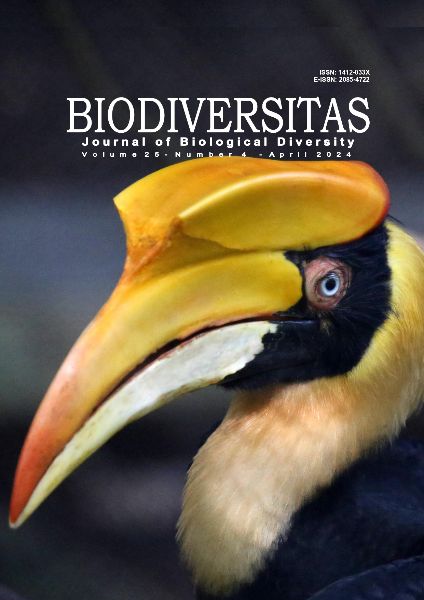Local community perceptions on the conservation of hornbill (Family Bucerotidae) in West Kalimantan, Indonesia
##plugins.themes.bootstrap3.article.main##
Abstract
Abstract. Kurniawan FH, Rahmansyah R, Rahman A, Hardiyanti, Kurniawan J, Putra ID, Hadiprakarsa Y. 2024. Local community perceptions on the conservation of hornbill (Family Bucerotidae) in West Kalimantan, Indonesia. Biodiversitas 25: 1702-1710. Effective wildlife conservation strategies must consider local community perceptions to develop effective actions. This study explored community attitudes toward hornbill conservation in West Kalimantan, Indonesia. Between November 2018 and August 2019, we interviewed 513 respondents in ten villages in Kapuas Hulu District, West Kalimantan Province, Indonesia. We collected data on respondent’s demographics, socioeconomic status, human-forest interactions, animal hunting trends, knowledge of hornbill, hornbill hunting, and hornbill-cultural knowledge. Most respondents were Dayak, relying on the forest for farming and harvesting for subsistence and commercial purposes. Seven out of eight Kalimantan hornbill species are targeted for hunting, with Helmeted hornbills being the most targeted species (80%) in the past five years. In addition, 12% of respondents reported hunting hornbills for food. Our result suggests that hunting is related to socioeconomic conditions, given that a significant proportion of respondents had no steady income (56%) and limited economic resources as farmers (38%), and a significant portion was unemployed (46%). A decline in the cultural value of hornbills was also recorded, with 61% of respondents did not know about it. The respondents who know, generally only understand the hornbill utilization in the traditional ornament matter and lost the sacred value. Additionally, in this study, cultural narratives were successfully recorded by some older respondents who were aware of the cultural value of hornbills from age >55 years old (27%). Hornbill ecotourism is suggested to enhance and fortify the socioeconomic well-being of sustainable conservation practices and mitigate the unsustainable use of hornbill. To enhance public awareness, we suggest conducting conservation education activities and awareness campaigns targeted at individuals within the age <35 years old, where a majority of respondents at these ages (45%) are unaware of the cultural value of hornbills. A community-based hornbill monitoring program is also recommended to raise public awareness, although funding for this aspect is currently very limited.


 https://orcid.org/0000-0001-8647-2305
https://orcid.org/0000-0001-8647-2305